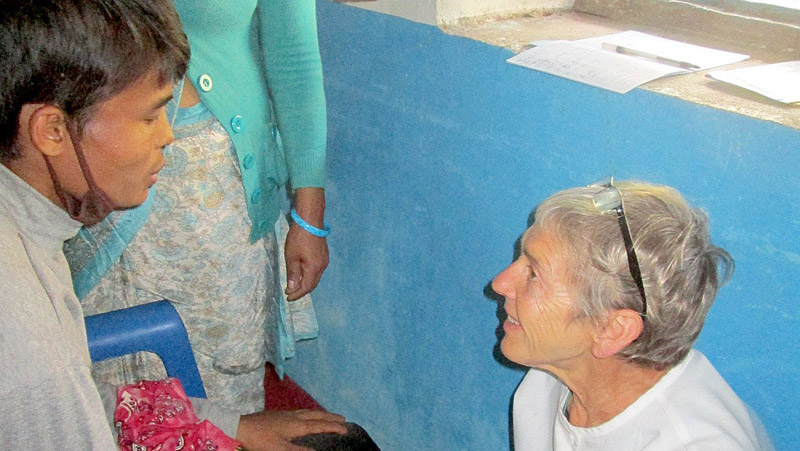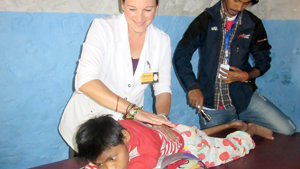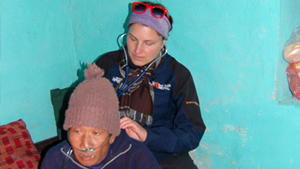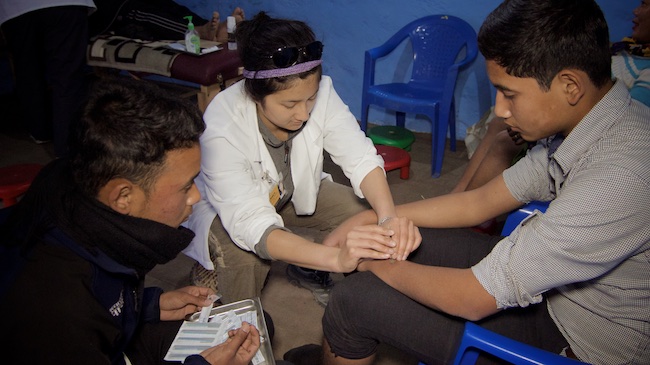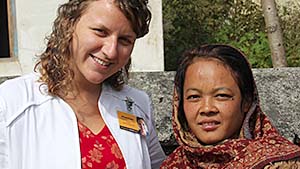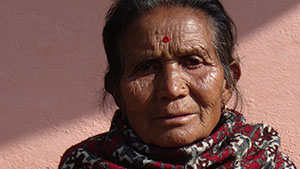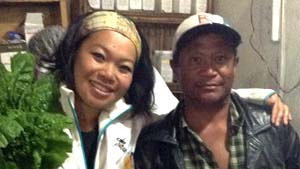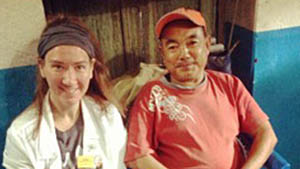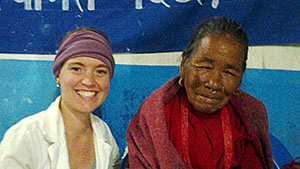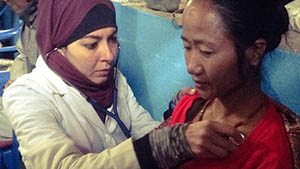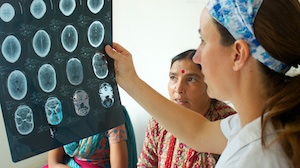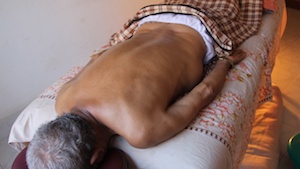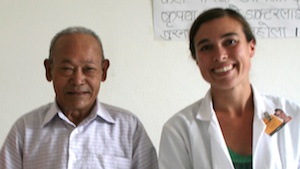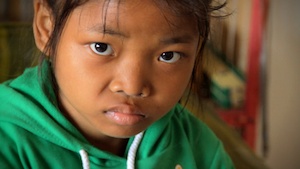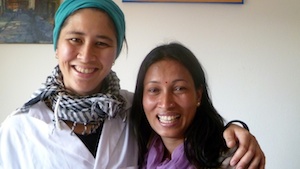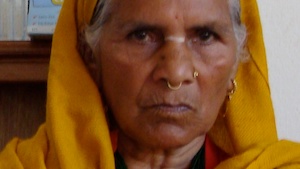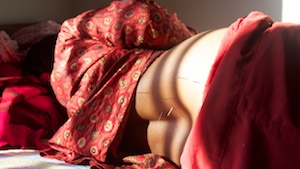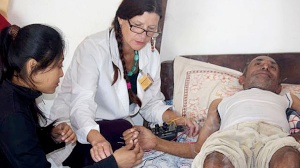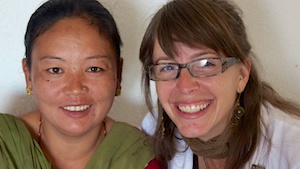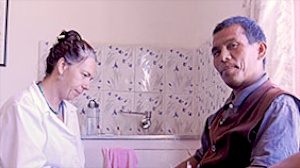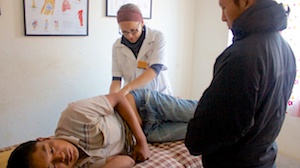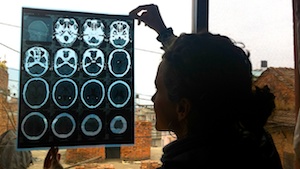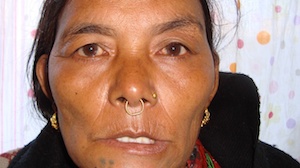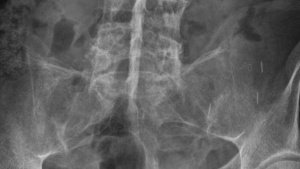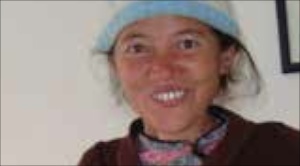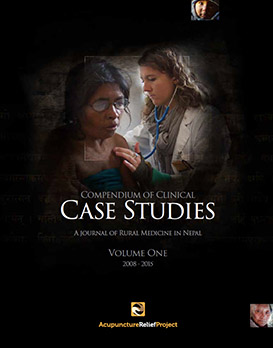Haley Merritt MAcOM
November 2013
OVERVIEW
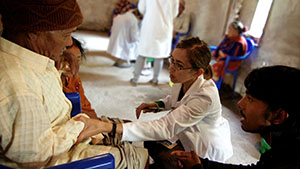
Patient presents with right-sided paralysis of his upper and lower limbs due to an ischemic stroke 9 months ago. Additional sequela includes speech impairment with the inability to say anything, but the phrase “la”. On presentation, this patient had not received any other post-stroke treatment. After 25 acupuncture treatments over 7 weeks, the patient was able to walk up to a ¼ mile without assistance, and showed partial control of his middle and index finger. He recovered the ability to say “tho” and “kho” in addition to “la.”
Subjective
76-year-old male presents with post-stroke paralysis and speech impairment. 9 months ago, the patient fell suddenly and experienced alternating sensations of paralysis and normalcy in the right half of his body. He also experienced impaired speech and left-sided facial deviation. He was taken to the College of Medical Sciences in Chitwan, Nepal 9 hours later. During his 9-day hospital stay, it was determined that he had experienced an ischemic cardiovascular accident affecting the left temporal lobe and was now suffering right-sided hemiplegia. This occurred due to an embolism occluding the bifurcation of the left carotid artery, likely due to risk factors including his age, gender and a history of high blood pressure, of which he was aware, but refused pharmaceutical treatment. He has not been back to see an allopathic doctor since his initial stay at the hospital. The patient presents at the Acupuncture Relief Project Kogate clinic with the chief complaint of loss of sensory perception and motor control of the right arm and most of the right leg. He has an unsteady gait and difficulty walking. He uses a cane and needs assistance in going down steps. He presents with speech impairment and is only able say the phrase "la" in Nepali.
His secondary complaint includes high blood pressure, which he now manages with a calcium channel blocker (Amlod 10mg PO QD), but admits to being inconsistent with his compliance. He has swelling in the lower legs, especially on the left side, which is better in the morning after resting, and worse during the day after walking. The patient was recommended by the hospital to go to physical therapy, but never went. Additional complaints include low back, abdominal, right-sided chest pain and constipation. Bowel movements occur once per 7 to 10 days, and on 1 occasion, 20 days.
Objective
It's clear that the patient’s condition, and inability to speak, create angst and frustration for him. His cognitive function appears to be impaired. When asked to perform certain tasks, like puffing out his cheeks or smelling a perfumed oil, he seems unsure of what is being asked of him and can not complete the task. The patient is relatively sensitive to acupuncture needles, especially on the left side of his body where his motor and sensory ability are still intact. When the needles hurt, he becomes angry, making him averse to acupuncture. His wife encourages him to get treatment, and she reports him being resistant to coming in.
The patient’s right arm is rigid and locked in an adducted and flexed position, clenched tightly to his body. He has no control over the movement of this arm, and when it is moved passively he feels pain. His right hand is clenched into a fist, and with passive extension, the fingers retract into a fist within 1 second. It is very difficult for the patient to move from a seated to a standing position and he needs assistance to stand up. He also needs help putting on his slip-on shoes. His right foot is slightly inverted and he walks on its lateral side. The patient appears to have very limited flexion of the hip and knee on the right side, and he often requires assistance going up-anddown steps. He also has a slight left-sided facial droop.
Neurologic testing of the cranial nerves shows some impairment of the trochlear and abducens, due to the patient’s inability to track upward or downward with his eyes. He does not have any hearing in his right ear, though this preceded the stroke. The facial nerve is impaired on the left side as described above. The accessory nerve is likely impaired due to his inability to elevate his shoulders on either side. All other cranial nerves test with normal function.
Deep tendon reflex testing on the right side shows brachioradialis (forearm) to be hyper-reflexive (+2). The hamstring and Achilles reflexes are hypo-reflexive (-1). All other reflex tests prove normal (0).
Sharp/dull sensory testing on the right upper and lower limb is inconclusive. This test made the patient very angry. He was not completely cooperative due to his inability to communicate the results. He does report pain with some needles in his right upper and lower limb indicating some sensory ability on his right side.
Blood pressure: 130/85
Pulse: Slippery and soft
Tongue: Pale and dusky with a thick, white coat and +2 vessel distention
Assessment
DX: Post-stroke sequelae with paralysis of the right upper limb, speech deficit and impaired movement of the right hip, knee and ankle
TCM DX: Wei syndrome due to qi and blood deficiency in the Yangming channels; Kidney yin and yang deficiency and Liver yin deficiency leading to Liver yang rising
Prognosis
The prognosis for full recovery is poor. The patient’s stroke caused damage to his brain that is unlikely to be repaired. However, a reduction in the rigidity of his right arm, with a possibility of some regained movement, is expected. Additionally, some improvement is expected with walking, a reduction in the swelling in his legs, and increased bowel movements. The area of his brain that controls speech may have been severely damaged by the stroke, which makes an improvement in speech unlikely. The treatment plan will be longterm and the patient needs to be invested in his recovery in order to be successful.
Initial plan
Treat with acupuncture 6x per week for 4 months with reassessment at every 12th treatment. Patient is very averse to strong stimulation. In order to keep him coming in for treatment, it is important to not overwork the patient. Typical treatment includes the use of scalp points along the motor and sensory lines of the upper and lower limbs, with stimulation of the upper limb sensory and motor points while extending the fingers and the forearm and abducting the shoulder on the right side. GB34, KI7, SP6, LV3, SP9, ST36 to ST43 needles 1 cun (1”) apart down the channel on the right side, LI11 to LI4, 1 cun apart down the channel on the right side. This style of needling is called pi ci technique.
The patient’s wife is asked to massage his legs with mustard oil daily, and elevate his legs above his heart for 30 minutes a day to reduce swelling. She is also asked to help him straighten his arms and legs daily to reduce rigidity. His wife is able to successfully perform the actions 80% of the time. The patient is recommended he go for at least 1 walk per day to increase his mobility. He seems happily compliant with this request.
The importance of taking his blood pressure medication regularly, and correctly, is emphasized to help prevent the patient from having another stroke.
Patient is prescribed Tao Ren Wan to increase his bowel movements and nourish blood and body fluids
Outcome
This patient was hard to communicate with since he can only say the phrase "la." Most of his progress was reported by his wife who came in with him daily for treatment. However, improvements could be seen in his overall condition. He had a reduction in the swelling in his legs, and was able to walk more easily. After 20 treatments, the patient began walking about 1/4 mile from his home to the clinic, and then back, every morning by himself. He was not able to walk on his own before he began treatment. He began to have bowel movements approximately every other day. His arm used to be flexed against his body at a 90 degree angle. It was now hanging loosely at his side at a 45 degree angle. His hand was no longer contracted into a fist, and his wife reported him scratching his head with his second and third fingers on the right hand while laying on his right arm. This showed improvement in motor control of some fingers. Movement of his second and third fingers had been observed during his most recent treatments. He also appeared to be in less pain with passive movement, judging by the fact that he didn't cry out in objection to the therapy, as he had before. He could now sleep on his right side and roll from side-to-side on his own, whereas before treatment this was not possible. He was also able to say the words "tho" and "kho" in addition to "la." Once during a treatment, when needles were very uncomfortable for him, he became very angry and shouted out a Nepali curse word. This is a combination of sounds that the patient had not been able to make since his stroke, showing progress in his speech. Since treatment, his wife reported him being able to say different phrases more easily while angry, and having an overall improvement in cognitive function.
Conclusion
With continued acupuncture treatments and help from his wife with stretching and massage, this patient will likely continue to improve. Full recovery of movement and sensation on the right side of his body is unlikely, but some progress is expected. In the same way, full recovery of speech is doubtful, but partial recovery is hoped for. Acupuncture will be vital for continued progress, and significant improvement would likely be seen within 6 months. To ensure that his increased motor function continues, it is important that his wife continues stretching and massaging his limbs, as well as encouraging him to exercise daily.
Discussion
This patient was very difficult for me to treat. I had very limited communication with him, and he was often very angry and easily agitated. He didn’t like the acupuncture and often didn’t understand how the treatments could be helpful. After a treatment with this patient, I would often feel very drained, discouraged and angry myself. I discovered a major barrier in my attachment to the acceptance and approval I normally receive from my patients. I was not receiving this approval from him, and instead, I received his anger and frustration. What I learned is that I needed to step back and be more objective and less reactive. By being more open, kind and patient towards him allowed him to be more responsive towards me. Once I adjusted my attitude, he was better able to understand that the acupuncture treatments were actually making a difference. Our relationship became more therapeutic, and we are now both happy to be working together.
A vital part of being a healthcare professional is creating a therapeutic environment that feels safe for the patient. In this environment, the patient can trust that the practitioner is there for them and cares about them. I have found that this relationship can make all the difference in the patient’s progress.












